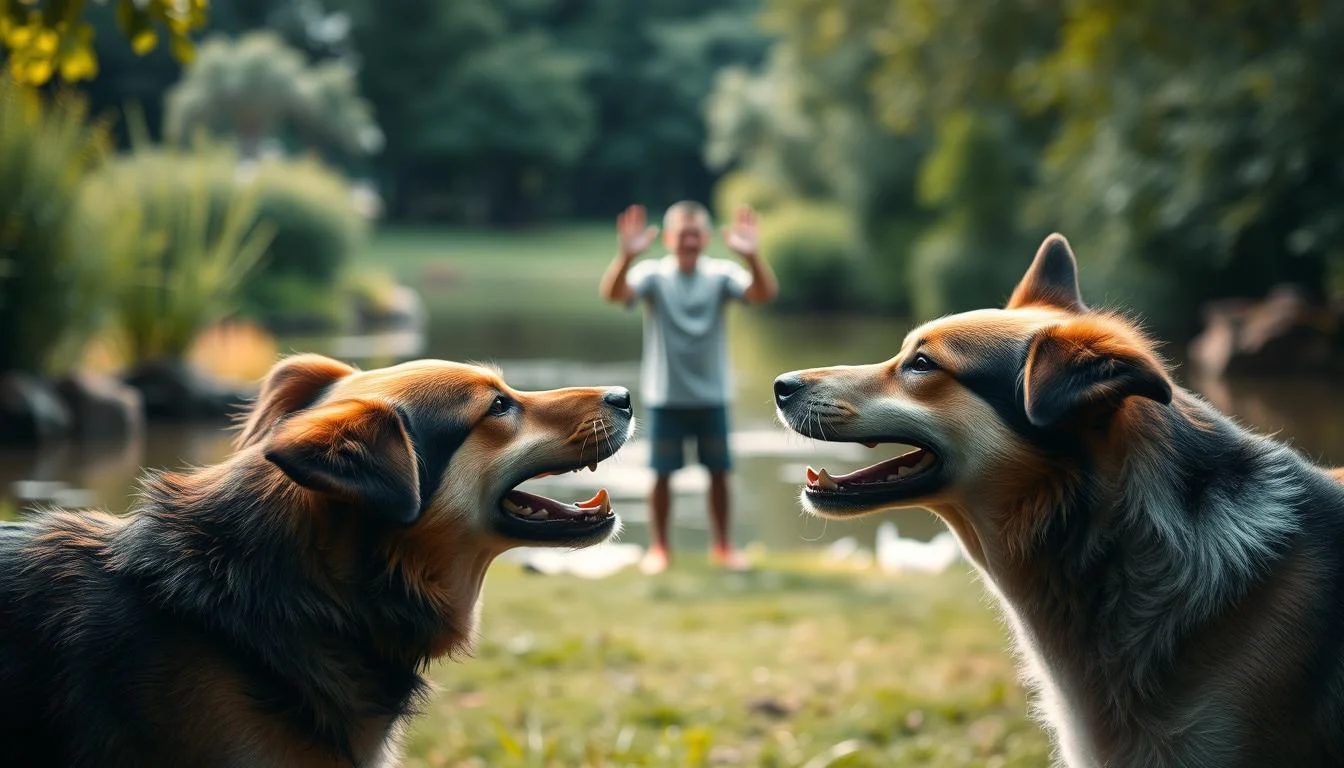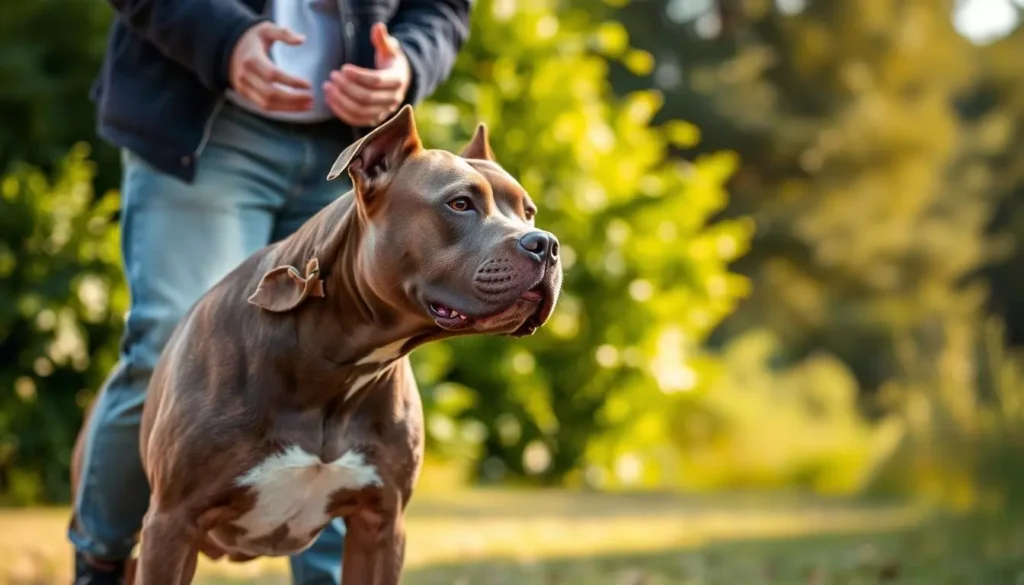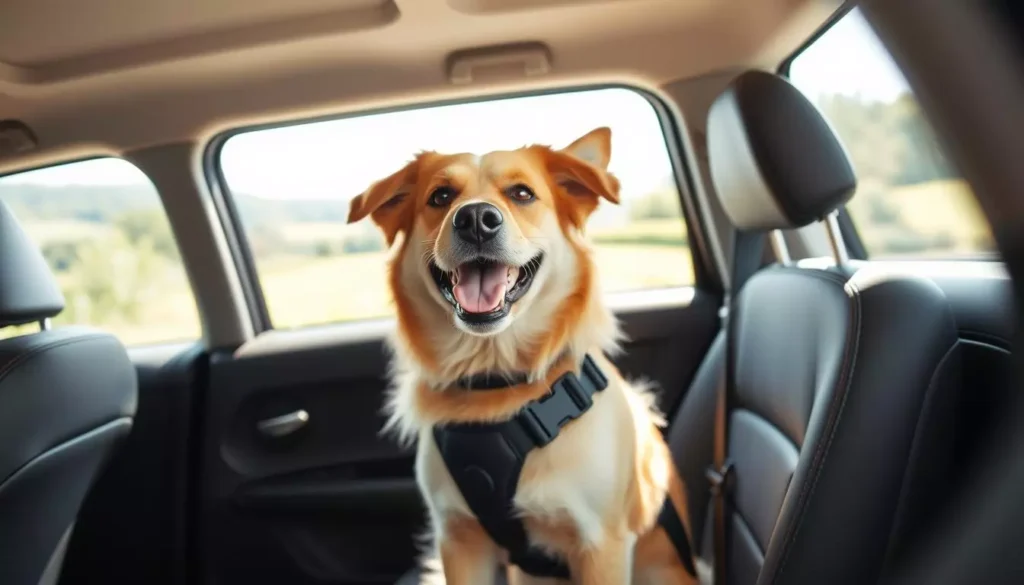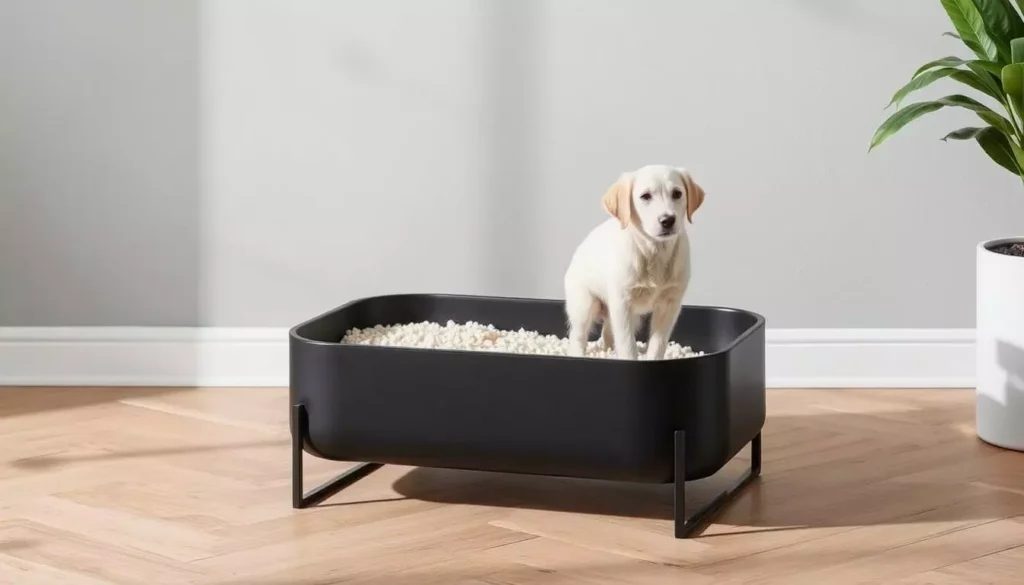Imagine the shock of seeing two dogs, once full of joy, turn against each other. I've been there, watching in horror as my pets show their anger. It's not just about the dogs; it's about our home and peace of mind.
Knowing how to stop a dog fight is key for their safety and our happiness. In this article, I'll share ways to prevent these scary moments. We can all enjoy our time together without fear.
Key Takeaways
- Understand common triggers for dog aggression.
- Recognize the difference between play and aggression.
- Implement preventative measures to avoid fights.
- Learn effective interventions for breaking up fights.
- Consult professionals for long-term behavior solutions.
Understanding the Reasons Behind Dog Fights
Every dog owner should know why their pets might fight. Knowing what makes dogs aggressive can stop fights before they start. Many reasons lead to this behavior, often from instinct or learned habits.
Common Triggers for Aggression
Aggression often comes from things dogs see as threats. When they feel their space or things they value are being taken, they might get angry. This can show in growling, snapping, or even fights. It's important to watch for these signs to stop problems early.
Identifying Resource Guarding Behavior
Resource guarding is when dogs protect their food, toys, or favorite spots. This can happen fast and needs watching closely. Spotting this in my dog has helped avoid fights with others.
The Role of Fear and Stress in Dog Behavior
Fear can make dogs defensive. Dogs under stress can be hard to predict. They might act aggressively when feeling trapped or scared. Things like the environment, health issues, or past traumas can cause these feelings. Knowing how fear and stress affect my dog helps me manage their interactions better.
How to Tell a Dog Fight from Rough Play
It can be hard to tell if dogs are playing or fighting. Different signs show if they are being friendly or aggressive. Watching their body language and sounds closely is key to stopping fights early.
Body Language Indicators of Play vs. Aggression
Dogs playing usually look relaxed. They might have open mouths or even seem to smile. Playful dogs often bow, showing they're just having fun.
But, aggressive dogs show tense signs. Raised hackles, stiff legs, or ears held high are warning signs. Knowing these signs helps tell play from aggression.
Understanding Vocalizations During Dog Interactions
Dogs' sounds tell us a lot about their mood. When they play, their barks and growls sound happy and light. But, if they growl low or bark harshly, they might be upset or scared.
Watching their sounds and body language together helps us understand if they're playing or fighting. This way, we can stop fights before they start.
Prevention Is the Best Policy
Being proactive can greatly reduce dog fights. It's key to understand and spot dog stress signals. Signs like tail tucking, vocalizations, and flattened ears show when a dog is stressed. It's important to catch these signs early, whether at home or in public.
Recognizing Signals of Stress in Your Dog
Knowing what stress signals dogs show helps us understand their feelings. Dogs may act differently when they're uncomfortable or anxious. This can get worse if we don't notice it. Common signs include:
- Vocalizations, such as whines or growls
- Tail tucking or standing still
- Flattened ears against the head
- Excessive sniffing or yawning
- Avoidance of eye contact or turning away
Strategies to Avoid Dog Fights in Shared Spaces
Using the right strategies can make shared spaces safer for dogs. For example, I introduce my dog to new places calmly. Some strategies include:
- Setting up proper introductions between dogs in neutral spaces.
- Avoiding overcrowded areas during busy times.
- Monitoring play interactions closely and stepping in if necessary.
- Organizing training sessions that focus on socialization skills.
How to Stop Dog Fight: Effective Interventions
When dog fights happen, it's crucial to act fast and safely. Using the right methods can greatly help in managing these situations. Techniques like distractions help us engage safely. They also help in separating the dogs and bringing back calm.
Distraction Techniques for a Safer Environment
To stop a dog fight from getting worse, distractions are key. Loud noises, like an air horn, can grab the dogs' attention. Spraying water is also effective, as it surprises them and stops their fight. Throwing a blanket can also help by blocking their view, giving them a chance to calm down.
Using Objects to Separate Fighting Dogs
If distractions don't work, we use objects to separate the dogs. Things like garbage can lids or big barriers work well. These objects create a safe space between the dogs, reducing the chance of them getting hurt. It's important to be careful when using this method to keep everyone safe.
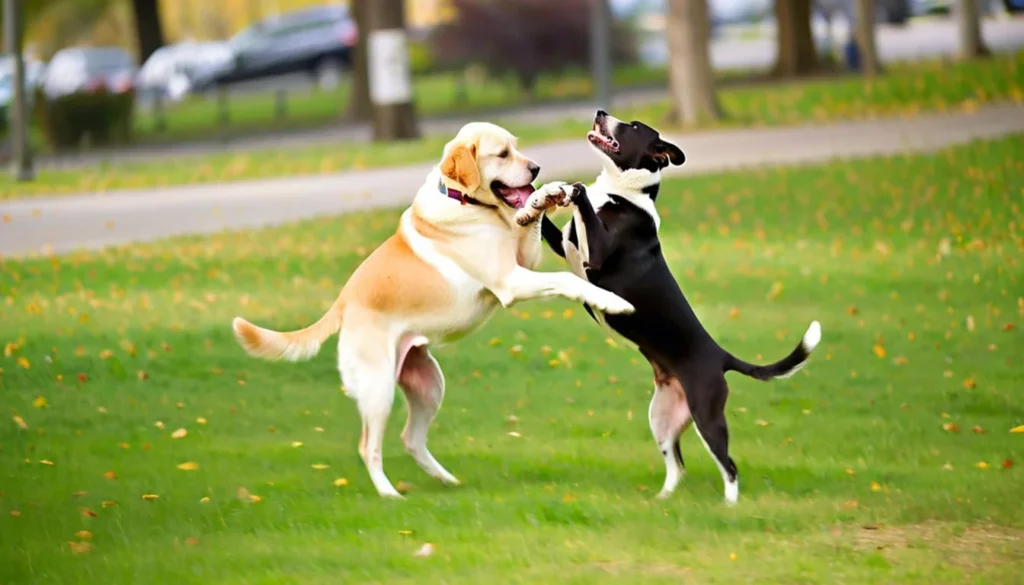
| Technique | How It Works | Benefits |
|---|---|---|
| Loud Noises | Distractions dogs with unexpected sounds | Quickly redirects attention |
| Spraying Water | Surprises and interrupts the aggression | Safe distance while distracting |
| Throwing Blankets | Limits visibility and interrupts focus | Eases tension between dogs |
| Using Barriers | Creates physical separation | Minimizes risk of injury |
Safe Methods for Breaking Up a Dog Fight
When dogs fight, safety is my top priority. I focus on methods that keep everyone safe. The wheelbarrow technique is especially effective.
Various Approaches to Minimizing Risk
Before stepping in, I carefully choose the safest way to separate the dogs. I might use:
- A loud noise or distraction to break their focus.
- Physical barriers like a chair or gate to separate them.
- The wheelbarrow technique to control them safely.
The Wheelbarrow Technique for Separation
This method involves holding the dogs by their hind legs. I make sure to grip both firmly and pull them away. It's a safe way to end the fight without getting hurt.
Learning the wheelbarrow technique helps me safely stop dog fights. It keeps both pets and people safe. By being careful, we can keep the peace when dogs are together.
Responding to Dog Fights at Home
Creating a peaceful home for our furry friends is key to avoiding dog fights. By making a calm environment and managing resources well, we can prevent fights. It's all about our daily routines and how we share things.
Creating a Calm Environment for Your Dogs
Starting with structured routines is the first step to a calm home. Dogs love knowing what's coming next, which helps them relax. Giving each dog their own space helps them feel safe and less likely to fight over things.
It's important to have separate spots for sleeping, eating, and playing. Regular training that focuses on positive interactions also helps keep the home stable.
Managing Resources to Reduce Competition
Managing resources is vital to avoid dog fights. Sharing toys and food can lead to aggression if not done right. By giving each dog their own things, we reduce the need to compete.
Here are some strategies I find helpful:
- Feeding dogs in separate areas to prevent resource guarding.
- Rotating toys to keep the environment fresh and engaging, lessening the fight over favorites.
- Implementing structured playtimes where I supervise interactions to encourage shared play, avoiding conflicts.
By managing resources and creating a calm space, we can greatly reduce dog fights at home.
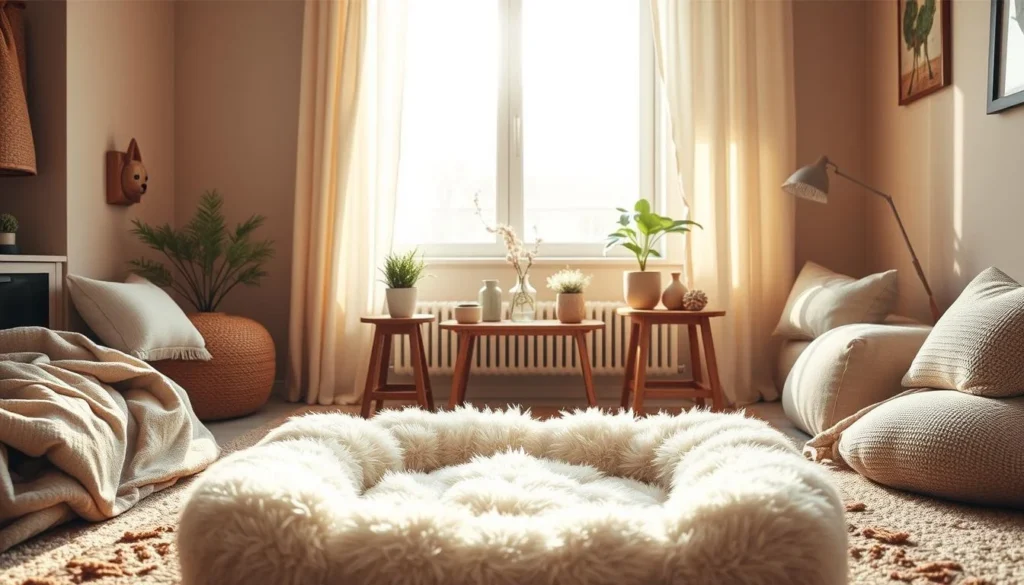
Stopping Dog Fights at the Dog Park
Dog parks are great for socializing dogs, but they can also lead to fights if we're not careful. It's important to introduce dogs slowly and watch their behavior. This way, we can make sure everyone has fun.
Best Practices for Introducing Dogs in Social Settings
Here are some key steps to prevent dog fights at the park:
- Start with a calm environment, introducing dogs on leash first.
- Allow some distance before bringing dogs closer to reduce initial excitement.
- Observe body language for signs of stress or discomfort.
- Let dogs meet gradually, ensuring they can withdraw from situations if needed.
- Encourage positive interactions with treats and praise.
Recognizing and Responding to Signs of Aggression
It's vital to know when dogs might get aggressive at the park. I look out for these signs:
- Tensed bodies and direct stares.
- Growling, snapping, or excessive barking.
- Raised hackles or lowered tails.
- One dog backing away or appearing anxious.
If I see these signs, I quickly step in to separate the dogs. Knowing these warning signs helps me keep the park a safe and happy place for all dogs.
How to Respond to Dog Fights Over Food and Toys
Stopping dog fights over food and toys is key to a peaceful home. Start by setting clear rules for sharing. This makes dogs feel safe and less likely to fight. Teaching them to wait and share is also crucial.
Establishing Rules for Resource Distribution
Creating rules for food and toys keeps things calm in a house with many dogs. Here's how to keep peace:
- Feed dogs in separate areas to avoid fights.
- Use special toys for each dog to stop guarding.
- Watch and guide play, especially with new toys.
Implementing Training Techniques for Impulse Control
Teaching dogs to control their impulses is important. I use positive methods to teach them. Here are some tips:
- Teach "wait" and "leave it" for food and toys.
- Practice feeding routines to teach patience.
- Give rewards for calm behavior around shared items.
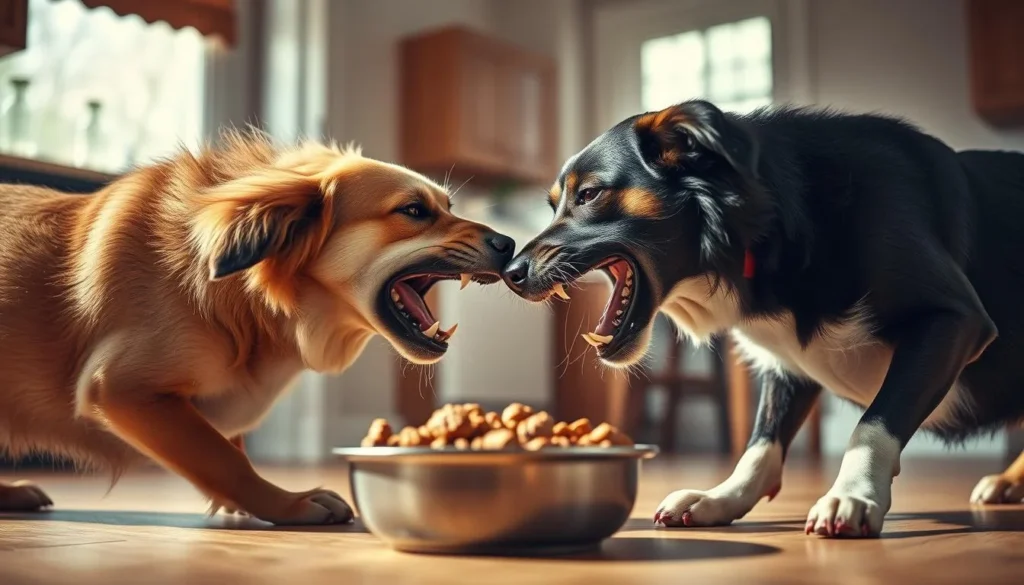
Living with Multiple Dogs: Encouraging Harmony
Creating a peaceful home for multiple dogs can be tough. But, the secret is to have a structured environment for dogs. Dogs feel safe and happy when they know what's coming next. This structure helps each dog and makes them get along better.
Setting Up a Structured Environment
A clear routine is key in a house with many dogs. Having set times for meals, walks, and play helps avoid fights and stress. Giving each dog its own food and toys stops them from fighting over things.
This setup makes sure every dog has its own space. It lets them grow and be happy together.
The Importance of Training and Socialization
Dog training and socialization are very important for peace. Training makes dogs and their owners closer. Socializing them helps them get along with others.
Going on group walks or obedience classes is great. It makes their interactions better. It also helps them learn to behave well in different places, keeping the home calm.
What to Do After a Dog Fight
After a dog fight, it's key to look after the physical and emotional health of the dogs. Knowing how to check for injuries is important. It helps avoid more problems and gets them the medical care they need.
Assessing Physical and Emotional Damage
After the fight, check each dog for injuries like cuts, bites, or bruises. Even without visible wounds, dogs can suffer emotionally. Look for signs like acting withdrawn, being more aggressive, or showing anxiety.
Checking for injuries is vital. Stress can make dogs behave differently, which might lead to more fights.
Consulting a Professional for Long-Term Solutions
Getting help from a professional is a smart move. An animal behaviorist or trainer can help understand why the fight happened. They can make a plan to help the dogs get better, learn to get along, and behave well.
Conclusion
In wrapping up my insights on how to stop dog fights, I want to stress the importance of understanding what triggers aggression. By knowing what causes fights and creating safe spaces, I can make my pets' lives better. This makes our home a calmer place.
As I've shown, the secret to peaceful dog relationships is in being proactive and educated. Recognizing stress signs and introducing dogs correctly in social settings is crucial. A structured environment helps reduce risks and encourages good behavior in my pets.
By using these tips to prevent dog fights and focus on safe interactions, I can make a great home for my pets. A bit of prevention leads to a happier life for all of us.

